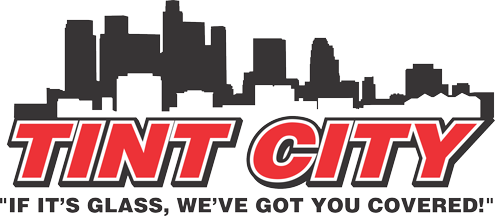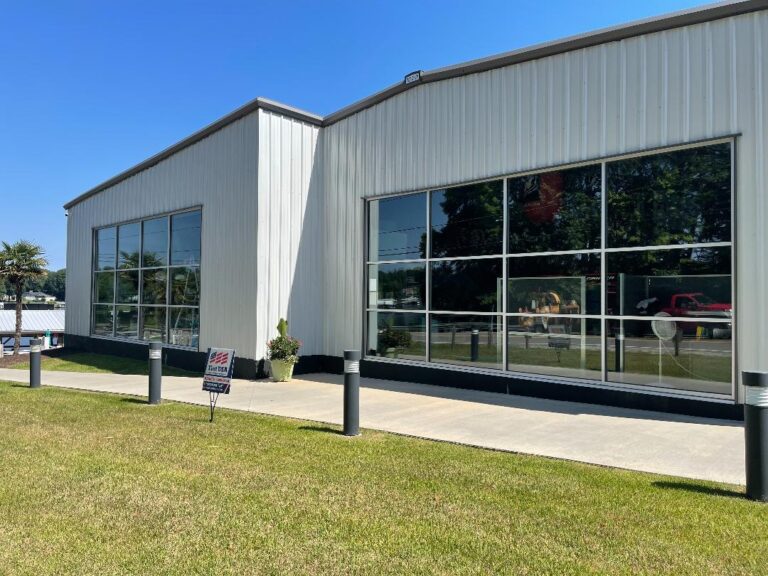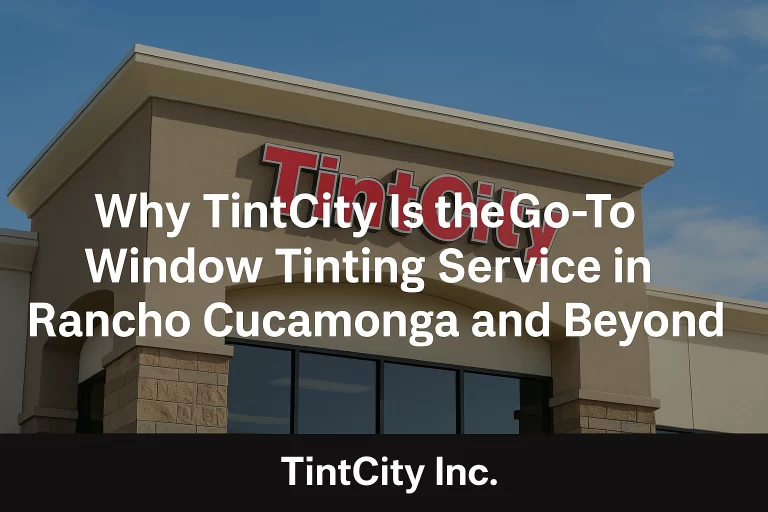Introduction to Commercial Window Tinting
Commercial window tinting is the process of applying a thin, transparent film to the windows of a business or commercial building. This specialized film is designed to provide a range of benefits that can significantly improve the overall comfort, energy efficiency, and aesthetics of a commercial space.
One of the primary advantages of commercial window tinting is its ability to regulate indoor temperatures. By blocking a substantial amount of the sun’s heat-generating infrared rays, tinted windows can reduce the strain on air conditioning systems, leading to lower energy costs and a more comfortable indoor environment for employees and customers alike.
Additionally, window tinting offers protection against harmful ultraviolet (UV) rays, which can cause fading and damage to interior furnishings, merchandise, and artwork. By filtering out up to 99% of UV rays, commercial window tints can help preserve the condition and appearance of valuable assets within a business.
Beyond energy savings and UV protection, window tinting can also enhance privacy and security. Certain tint films can obscure the view from the outside, providing a sense of seclusion for occupants while deterring potential intruders or unwanted attention.
For businesses in Southern California, where the intense sunlight and high temperatures can pose significant challenges, commercial window tinting is an increasingly popular and cost-effective solution. By mitigating the effects of harsh sunlight, window tints can create a more comfortable and productive work environment, ultimately contributing to the overall success and profitability of a business.
The Southern California Climate Challenge
Southern California’s warm and sunny climate poses unique challenges for businesses when it comes to managing energy costs and maintaining a comfortable indoor environment. With an abundance of sunlight and high temperatures, buildings in this region are susceptible to excessive heat gain, leading to increased energy consumption for cooling systems and potential discomfort for employees and customers.
The intense sunlight in Southern California can cause interior spaces to heat up rapidly, putting a strain on air conditioning units and driving up energy bills. This is particularly problematic during the summer months when temperatures can soar above 90°F (32°C) for extended periods. Unmitigated sun exposure can also lead to fading and damage to interior furnishings, carpets, and merchandise, resulting in additional costs for businesses.
Moreover, the glare from direct sunlight can create an uncomfortable and harsh working environment, negatively impacting employee productivity and potentially contributing to eye strain and headaches. This issue is particularly prevalent in offices with large windows or open floor plans, where sunlight can penetrate deeply into the interior spaces.
By addressing these climate-related challenges, businesses in Southern California have an opportunity to reduce their energy costs, improve indoor comfort, and enhance overall operational efficiency.
Cost Analysis: Initial Investment
The upfront costs of commercial window tinting can vary significantly based on several factors. However, it’s essential to consider this investment as a long-term solution that can provide substantial returns through energy savings, increased comfort, and enhanced property value.
One of the primary factors influencing the initial cost is the size of the windows or glass surfaces to be treated. Generally, larger windows or more extensive glass areas will result in higher costs due to the increased material and labor required. Additionally, the type of window film selected can impact the overall cost. Higher-quality films, such as those offered by 3M, may have a higher price tag but often provide superior performance and longevity.
Other factors that can affect the cost include the complexity of the installation, accessibility to the windows, and any specialized equipment or techniques required for the project. For example, tinting windows on multi-story buildings or those with unique architectural features may require additional labor and specialized equipment, resulting in higher costs.
On average, commercial window tinting for a small to medium-sized business in Southern California can range from $5 to $10 per square foot of glass area. However, it’s essential to obtain customized quotes from reputable providers like Tint City, as costs can vary based on the specific project requirements.
While the initial investment may seem significant, it’s crucial to consider the long-term benefits and potential cost savings that commercial window tinting can provide. By reducing energy consumption, improving occupant comfort, and extending the lifespan of interior furnishings and equipment, the investment can pay for itself over time through lower utility bills and reduced maintenance costs.
Potential Energy Savings
One of the primary benefits of investing in commercial window tinting is the potential for significant energy savings. In Southern California’s hot and sunny climate, air conditioning systems work overtime to maintain comfortable indoor temperatures. By blocking a substantial portion of the sun’s heat-producing rays, high-quality window tints can reduce the strain on HVAC systems, leading to lower energy consumption and cost savings.
According to industry estimates, window tinting can block up to 79% of solar heat gain, translating to a 15-30% reduction in cooling costs for commercial buildings. This not only results in direct cost savings on utility bills but also extends the lifespan of air conditioning units by reducing their workload.
Furthermore, window tints can help retain heat during cooler months, minimizing the need for excessive heating. This dual benefit ensures year-round energy efficiency, making window tinting a worthwhile investment for businesses seeking to optimize their energy usage and reduce their carbon footprint.
Tint City’s partnership with 3M ensures access to cutting-edge window film technology, engineered to deliver maximum energy savings while maintaining optimal visibility and aesthetics. With professional installation and high-quality materials, businesses can expect to recoup their investment through reduced energy costs within a few years, making commercial window tinting a smart choice for cost-conscious and environmentally conscious organizations.
Extending Equipment Lifespan
Window tinting plays a crucial role in protecting the interiors and equipment of commercial buildings from the damaging effects of ultraviolet (UV) radiation. The intense Southern California sun can wreak havoc on everything from office furniture and flooring to electronics and machinery, leading to premature deterioration and costly replacements.
By installing high-quality window films, businesses can create a barrier against up to 99% of harmful UV rays. This protection helps to prevent fading, discoloration, and brittleness in materials like fabrics, plastics, and woods. As a result, office chairs, desks, carpets, and other furnishings maintain their vibrant colors and structural integrity for much longer.
Moreover, window tinting safeguards sensitive electronic equipment from UV damage. Prolonged exposure to ultraviolet radiation can cause components to degrade, leading to malfunctions, shortened lifespan, and potential data loss. By shielding computers, printers, and other devices from these harmful rays, businesses can extend the usable life of their equipment, reducing replacement costs and downtime.
In addition to UV protection, window films also help regulate interior temperatures, preventing excessive heat buildup that can strain HVAC systems and cause premature wear and tear. By reducing the workload on these systems, window tinting contributes to their longevity, further minimizing maintenance and replacement expenses.
Overall, investing in commercial window tinting from reputable providers like Tint City is a cost-effective strategy for extending the lifespan of a wide range of interior assets, from furnishings and flooring to electronics and HVAC systems. By shielding these valuable resources from the relentless Southern California sun, businesses can enjoy significant long-term savings and a more sustainable operating environment.
Employee Comfort and Productivity
Commercial window tinting can significantly enhance employee comfort and productivity within the workplace. The Southern California region is known for its intense sunlight and high temperatures, which can create an uncomfortable indoor environment if not properly managed. By installing high-quality window films from reputable manufacturers like 3M, businesses can mitigate the effects of solar heat gain and glare, leading to improved thermal comfort for their employees.
Excessive heat and glare can cause eye strain, headaches, and fatigue, all of which can negatively impact an employee’s ability to concentrate and perform at their best. Window tinting acts as a barrier against these disruptive elements, reducing the amount of solar radiation entering the building. This results in a more consistent and comfortable indoor temperature, minimizing the need for constant adjustments to the HVAC system.
Moreover, the reduction in glare provided by window films enhances visual comfort, allowing employees to work more efficiently without the need for constant squinting or repositioning to avoid bright spots on their computer screens or workstations. This improved visual clarity can lead to increased productivity and reduced eye strain, ultimately contributing to better overall employee well-being.
By prioritizing employee comfort and productivity through commercial window tinting, businesses can create a more pleasant and conducive work environment. This not only benefits their workforce but can also lead to increased job satisfaction, reduced absenteeism, and higher overall employee retention rates.
Tint City and 3M Window Films
Tint City is a leading provider of commercial window tinting services in Southern California, with locations in Rancho Cucamonga, Loma Linda, Corona, and La Verne. They have built a reputation for exceptional service and quality workmanship, partnering with industry leader 3M to offer top-of-the-line window film solutions.
3M is a global leader in the window film industry, renowned for their innovative and high-performance products. Their window films are designed to provide superior heat rejection, glare reduction, and UV protection, making them an ideal choice for businesses in the hot and sunny Southern California climate.
Tint City’s team of experienced professionals is trained and certified by 3M to ensure proper installation and optimal performance. They use only the highest quality 3M window films, which are backed by comprehensive warranties and guaranteed to meet or exceed industry standards.
With a wide range of 3M window film options available, Tint City can tailor solutions to meet the specific needs of each business, whether it’s enhancing energy efficiency, reducing glare and eye strain, or improving privacy and security. Their commitment to customer satisfaction and attention to detail ensure a seamless and hassle-free experience from start to finish.
Return on Investment Analysis
Commercial window tinting represents a significant upfront investment for businesses in Southern California. However, the long-term cost savings and benefits can often outweigh the initial expense, making it a worthwhile consideration. To evaluate the potential return on investment (ROI), it’s essential to analyze several key factors.
One of the primary cost-saving advantages of window tinting is reduced energy consumption for cooling. With the intense Southern California sun, buildings can experience substantial heat gain through untreated windows, leading to increased air conditioning usage and higher utility bills. By blocking a significant portion of the sun’s heat and UV rays, high-quality window films like those offered by 3M can lower cooling costs by up to 30%.
To calculate the potential energy savings, businesses can consider their current cooling expenses, the size and orientation of their windows, and the specific tint film’s solar heat rejection capabilities. Tint City’s experts can provide detailed energy analysis and projections based on the building’s unique characteristics.
In addition to energy savings, window tinting can extend the lifespan of interior furnishings, flooring, and equipment by reducing exposure to damaging UV rays. This can translate into cost savings by delaying the need for replacements and repairs. Furthermore, the improved occupant comfort provided by tinted windows can boost employee productivity, leading to indirect cost benefits.
To determine the overall ROI, businesses can estimate the total cost of the window tinting project, including materials and labor, and compare it to the projected cost savings over time. The payback period, which is the time it takes for the savings to equal the initial investment, is a crucial factor in evaluating the financial viability of the project.
Tint City’s professionals can provide detailed ROI calculations and projections tailored to each business’s specific circumstances, taking into account factors such as building size, window area, existing energy usage, and the chosen tint film’s performance characteristics. By considering both the direct and indirect cost savings, businesses can make an informed decision about the potential return on their investment in commercial window tinting.
Case Studies and Customer Testimonials
Acme Manufacturing, Riverside
Acme Manufacturing, a leading industrial firm in Riverside, faced soaring energy costs and uncomfortable working conditions due to the intense Southern California sun. After installing 3M window films by Tint City, they reported a 25% reduction in cooling costs and a significant improvement in employee comfort and productivity. “The window tinting has been a game-changer for our facility,” said John Smith, Facilities Manager. “Not only have we seen a substantial decrease in our energy bills, but our employees are happier and more focused without the harsh glare and heat.”
The Vine Hotel, Temecula
The Vine Hotel, a luxury resort in Temecula’s wine country, sought to enhance guest comfort and reduce energy consumption. After consulting with Tint City, they opted for 3M’s premium window films, which blocked up to 60% of solar heat while maintaining a clear view. “Our guests have raved about the improved comfort in their rooms, and our energy costs have dropped significantly,” said Sarah Johnson, General Manager. “The window tinting has been a worthwhile investment that has paid for itself multiple times over.”
Inland Valley Medical Center, Rancho Cucamonga
Inland Valley Medical Center, a prominent healthcare facility, recognized the importance of energy efficiency and patient comfort. By partnering with Tint City, they installed 3M window films throughout their facility, resulting in a 20% reduction in cooling costs and improved patient satisfaction. “The window tinting has created a more comfortable and healing environment for our patients and staff,” said Dr. Michael Williams, Chief of Staff. “We’re proud to have taken this step towards sustainability while enhancing the overall patient experience.”
Environmental and Sustainability Benefits
Window tinting plays a crucial role in promoting energy efficiency and environmental sustainability for commercial buildings. By reducing the amount of solar heat gain entering through windows, tinted glass significantly lowers the cooling load on air conditioning systems. This translates into substantial energy savings and a reduced carbon footprint for businesses.
The installation of high-quality window films, such as those offered by 3M, can block up to 78% of the sun’s heat-producing rays. This remarkable heat rejection capability minimizes the need for excessive cooling, leading to lower energy consumption and reduced greenhouse gas emissions associated with electricity generation.
Moreover, window tinting helps extend the lifespan of interior furnishings and merchandise by filtering out harmful ultraviolet (UV) rays. This not only protects valuable assets but also reduces the need for frequent replacements, further contributing to environmental sustainability by minimizing waste and resource consumption.
By embracing commercial window tinting solutions, Southern California businesses can actively participate in the global effort to mitigate the impacts of climate change. As energy efficiency becomes increasingly crucial, window tinting emerges as a cost-effective and environmentally responsible solution, aligning businesses with their corporate social responsibility goals and demonstrating their commitment to a greener future.
Conclusion and Next Steps
In conclusion, investing in commercial window tinting from a reputable provider like Tint City can be a highly cost-effective solution for businesses in Southern California. By leveraging the expertise of Tint City and the advanced technology of 3M window films, companies can enjoy a wide range of benefits, including reduced energy costs, extended equipment lifespan, improved employee comfort and productivity, and a positive impact on the environment.
The comprehensive analysis presented in this guide has highlighted the substantial return on investment that can be achieved through window tinting. By addressing the unique challenges posed by the Southern California climate, businesses can proactively mitigate the negative effects of excessive heat and glare, creating a more comfortable and efficient workspace for their employees.
To take the next step towards realizing these benefits, we encourage businesses to schedule a consultation with Tint City. Their knowledgeable professionals will assess your specific needs and provide tailored recommendations for the most suitable window tinting solutions. Don’t hesitate to embrace this cost-effective investment and experience the transformative power of window tinting for your commercial property.




